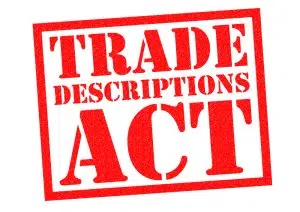
The Trade Descriptions Act affects businesses in several ways. First, it requires businesses to be honest and transparent in their marketing and advertising. Second, it prohibits businesses from engaging in deceptive practices that could mislead or deceive consumers. Finally, the Act gives the CMA the authority to take enforcement action against businesses that violate the law.
All owners of business ventures need to understand the Trade Descriptions Act and Consumer Protection from Unfair Trading Regulations. Get a better understanding of these laws, including what they are and what they mean for your company.
To ensure businesses are truthful about what they sell, the Trade Descriptions Act was created. These laws have been largely superseded by newer consumer protection laws.
What is the Trade Descriptions Act?
On 30th November 1968, the Trade Descriptions Act was introduced as consumer rights legislation. As a result, consumers are protected from misleading product and service claims.
To do otherwise is an offence under this new law, which replaced the Merchandise Marks Act of 1887.
The following are examples of breaches of trade descriptions:
- Fake designer handbags marketed as authentic
- Inaccurately stating the wattage of a microwave
What does the Trade Descriptions Act cover?
Businesses need to understand what they can and cannot claim about their products and services under the Trade Descriptions Act 1968. Among the provisions of the legislation are:
- Misinformation is prohibited in the sale of products or services
- Allows officials to inspect goods and documents and confiscate them
- Provides courts with the authority to punish businesses or individuals that violate the rules
- If a business breaches the Act, fines will be issued
What is a trade description?
This is the information a business or seller provides about the products or services they sell. By doing so, it helps customers better understand what they are purchasing before they make a purchase decision.
Trade descriptions for products and services must include the following items:
- Quantity, size, or gauge
- Manufacturing, production, processing, or reconditioning methods
- Its composition
- A product’s strength, performance, accuracy, behaviour, and suitability for a particular purpose
- Results of the tests that were conducted
- Manufacturing, production, processing, or reconditioning location or date
- Manufacturers, producers, processors, or reconditioners
- Any previous ownership or use
- In addition to those listed above, there are other physical characteristics
Detailed information about what a trade description is and includes can be found in section two of the full legislation.
Origins of the Trade Descriptions Act and consumer protection laws
Merchandise Marks Act was repealed and replaced by the Trade Descriptions Act in 1968. In order to ensure that businesses are trustworthy and treat their customers fairly, many types of consumer laws have been introduced over the years.
A consumer protection law like this was one of three – the other two were:
The Consumer Credit Act (1974)
This regulation regulates consumer credit, such as loans and hire purchases, and was updated and amended in 2006.
As stated in the document:
- Credit must be provided by a licensed business
- A loanee must be at least 18 years old
- APR (annual percentage rate) must be clearly stated
- A cooling-off period must also be available to the consumer
The Sale and Supply of Goods Act (1994)
According to this act, your business must sell or supply goods that are of ‘satisfactory quality’.
They need to:
- Be safe
- Be properly fit for use
- Not have any faults
- Be able to last for a reasonable amount of time
Businesses must also comply with employment and intellectual property laws in addition to consumer laws.
Is the Trade Descriptions Act still valid today?
However, the Trade Descriptions Act has mostly been replaced by the Consumer Protection from Unfair Trading Regulations Act (2008). To prevent rogue traders from exploiting loopholes, this was done.
Sellers were prohibited from engaging in 31 unfair practices under the 2008 legislation, including:
Pressure selling and aggressive sales techniques
There are several unsavoury practices involved here, such as:
- Unwanted communication – either by phone or email
- Not leaving a customer’s home when requested
- A requirement that a consumer sign a contract or agreement before leaving your business premises
False endorsements
A company cannot tell a customer it is a member of a trade organisation when it is not. Additionally, misrepresenting that an independent body or organisation has approved your products when it hasn’t been illegal. It is always best to steer clear of anything untrue about your business, services, or products.
Misleading actions
When a consumer is presented with truthful information, they would not make the decision you are trying to influence. Selling or advertising can result in such a scenario. A product’s where, when, and how information can be amended or withheld.
Misleading omissions
Informed decisions are made by customers when retailers hide information at the time of purchase. The same reason applies to unclear information. It is impossible for a consumer to make an informed decision without receiving relevant and accurate information before parting with their money.
What counts as a misleading or aggressive trading practice?
The practices of misleading and aggressive are prohibited when dealing with consumers in the event that they are likely to affect the average consumer’s decision. Misleading or aggressive practices can include:
- providing false information (for example, about a product, its benefits and so on)
- omitting important information
- creating confusion with competitors’ products (for example, by giving your product a name very similar to a leading brand)
- failing to follow the rules of a code of conduct to which you subscribe
- harassing, coercing or unduly influencing consumers, either physically or psychologically.
The best practice to prevent yourself from engage in misleading or aggressive practices is to deal honestly and fairly with your customers.
How to prevent your business from breaching regulations
With consumer protection and trade descriptions legislations, businesses of all sizes have a lot to consider. By simply following a customer-first approach, your business can avoid breaking regulations even if it seems overwhelming at first. You’ll be able to satisfy customers if you have relevant processes that positively serve them.
You can prevent your business from violating these regulations by following these tips:
- Make sure you are complying with the law and maintaining a good reputation by reading relevant legislation
- From conception to supply and customer service, design your processes with the law in mind
- Ensure your products and services match how you describe them by creating a multi-step quality check process
- Ensure all contracts your business enters do not contain unfair terms for consumers. The customer is not bound by it if they do
- Provide a customer service process that assures consumers that you are serious about their rights and about the quality of your products and services. Refunds and returns should be documented in an official policy. If a product doesn’t meet standards, issue a refund within 30 days
- Make sure your business is insured. A product that causes injury, illness, or damage can be covered by this insurance if it is produced, manufactured, designed, repaired, or supplied by a company.
Conclusion
The Trade Descriptions Act (TDA) is a piece of UK legislation that seeks to protect consumers from false or misleading descriptions of goods and services. It has a significant impact on businesses as it requires them to ensure that their products or services are accurately described and meet the standards advertised. Any business found to be in breach of the TDA may face legal action, fines, and damage to their reputation.
Therefore, companies must be diligent in ensuring that all claims made about their products or services are true, accurate, and not deceptive. By complying with the TDA, businesses can establish trust with their customers, protect their brand reputation, and avoid legal and financial consequences.
Lee Jones is a seasoned Business Finance Specialist with over two decades of invaluable experience in the financial sector. With a keen eye for market trends and a passion for helping businesses thrive, Lee has become a trusted advisor to countless organizations seeking to navigate the complexities of finance.


